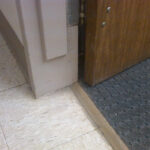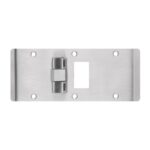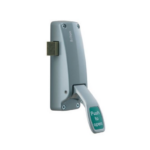 This is another one for my code development wish list…
This is another one for my code development wish list…
The typical height for a dutch door shelf is usually 39-42 inches above the floor. It can be tricky to coordinate the latching hardware in the bottom leaf – the lever handle is often mounted in a lower location than normal. For doors on an accessible route and doors in a means of egress, operable hardware has to be mounted between 34 inches and 48 inches above the floor (some codes and standards exempt locks used only for security purposes from this mounting height). Given the typical shelf location and required hardware location, this can be done if coordinated properly. However, I have had several questions lately regarding the shelf height required by the accessibility standards.
According to the 2010 ADA Standards, a sales and service counter is required to be no more than 36 inches above the floor. With a shelf mounted at this height, operable hardware in the bottom leaf of the dutch door could not be within the required height range of 34-48 inches above the floor without conflicting with the dutch door shelf. The question is whether a dutch door shelf is a counter or a shelf, by ADA standards. Although the ADA standards don’t reference dutch door shelves specifically, other types of shelves may be mounted between 40 and 48 inches above the floor. If a dutch door shelf is considered a shelf, it is possible to meet the requirements for the shelf height and the hardware height, but the purpose of most dutch doors used in commercial and institutional applications is more like a sales and service counter than a shelf.
WWYD to ensure that a dutch door shelf and the operable hardware meet the accessibility standards?
The Steel Door Institute publishes a standard for dutch doors – SDI 111-B, which can be downloaded at www.steeldoor.org (click on SDI 111-09).
You need to login or register to bookmark/favorite this content.






Can it really be called a service counter if you are not able to mount a point-of-sales machine to it? If there is no sales happening technically at that location would it not just be a shelf/opening you hand items through?
I can’t find a definition or anything to help me prove whether it’s a service counter or not, but in the absence of prescriptive information in the standard, some code officials are interpreting the shelf as a counter.
Use a wicket door for the counter
https://en.wikipedia.org/wiki/Wicket_gate
The closest that we can mount a cylindrical lock under a dutch door shelf is 2 1/2″. So with a 36″ high shelf (AFF), that would put the lock at 33 1/2″ AFF to CL. I find the question you posed an interesting problem. Can’t wait to read other thoughts on this. And, we have typically seen the shelf at 40″ AFF, as shown in the SDI standard that you referenced.
I usually recommend a “door within a door” solution.
Leave the hardware where it is, and cut out a door inside the door instead of using a dutch door.
Much easier to secure both openings this way, and won’t interfere with hardware heights.
Plus One ! 🙂
I have a Dutch door opening with architect’s drawing showing Dutch shelf height @34 A.F.F. with Schlage full mortised lock in bottom leaf. The top leaf has a long narrow lite kit with bottom of visible lite @ 43″ A.F.F. It is a hollow metal frame. My lever is WAAAAY too low in the door. If I raise the Dutch cut to accommodate the lock, the lite is too high and will not meet ADA compliance. What are my options for correcting this opening?
Hi Barbara –
You could move the shelf up, assuming that the shelf is considered a shelf (40-48″ AFF) and not a counter (36″ AFF) for accessibility. That would get the lock up into the allowable range (34-48″ AFF). To meet the vision light requirements, you could add a second light in the bottom leaf, creating a long narrow light that is interrupted by the shelf. This is compliant with the accessibility standards, as long as the light kit or molding doesn’t project into 10-inch area measured from the floor up the face of the door. I hope this makes sense, and I’d love a photo if the door is built this way. 🙂
– Lori
For a Dutch Door Service counter I have had the shelf placed at 36″ AFF. The bottom leaf had a rolling latch on it to keep it closed when the top leaf is open. The top leaf has a mortise lock on it that meets all lever height requirements. There is still a dutch door bolt used to secure the top leaf to the bottom leaf when both doors are closed.